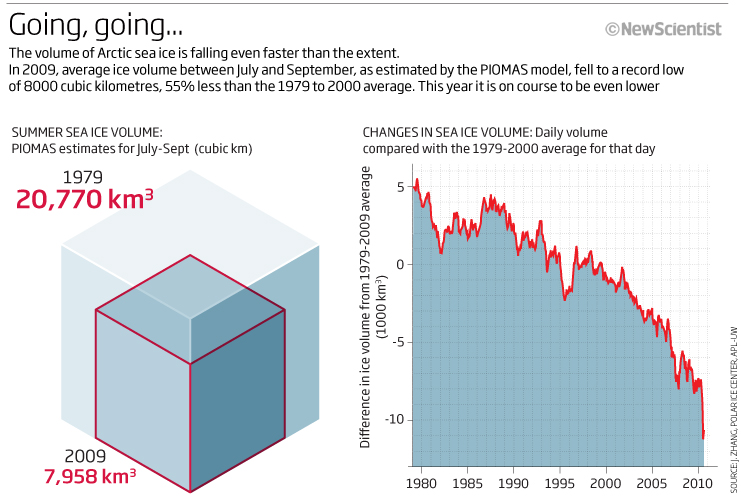Arctic Sea Ice Near Record Low; Sea Level Unaffected
The North Pole has been surrounded by the polar ice cap for more than a million years. It is now closely monitored as an indicator of climate change, or global warming. The size of the Ice sheets and glaciers are excellent LONG-TERM indicators of atmospheric temperature. It may not necessarily correlate with a single year or two, but over longer periods of time, the amount of ice will decrease as average global temperature increases.
Ominously, the amount of ice has been generally decreasing for years. September is the period of minimum sea ice each year and is used to get a fair comparison with other years. The results continue to raise grave concern. While 2007 was an exceptionally low year in terms of Arctic Ice Volume, 2009 is now the second lowest year on record and the results will soon be in for 2010. See this chart of Arctic Sea Ice Volume.
You may have seen different stories or maps of the sea ice extent showing how the Arctic region has melted over the last decade. A few interesting facts to point out:
- While the usual map and satellite photos show the AREA of sea ice, they rarely depict that the ice is also THINNING, which means the total VOLUME of ice is disappearing even faster than the square miles of ice. The charts above, from New Scientist Magazine show just how dramatically the volume is eroding.
- It is estimated the the Arctic Ocean (North Pole) will be generally ice free in a few decades, the first time in millions of years. Not only is this proof positive that the planet is getting unusually warm, the lack of that ice mass will have profound effects, including further changes to the weather patterns that we have come to expect through all of human history. It should be noted that there may also be some benefits such as shorter shipping routes over the Arctic – the fabled Northwest Passage; improved agriculture in the high northern latitudes; access to potential oil deposits.
- Once the polar ice cap is gone, the models indicate that it will not return for thousands of years, or longer. So this is effectively a permanent change.
- It is commonly assumed that the melting polar ice cap is a significant factor in sea level rise. That is NOT the case, as the ice around the north pole is floating sea ice. As it melts, it does not add to the level of the liquid, just as melting ice cubes in a glass do not. Rising sea level is primarily the result of two effects:
- Thermal Expansion – the ocean has been warming for about a century, by roughly one degree. As water warms, it expands ever so slightly, like most substances. With the ocean having an average depth greater than 2 miles, the effect of thermal expansion is somewhere in the area of 6 – 8 inches.
- The greater factor in sea level rise is the melting of the ice sheets and glaciers that are on land, which flow into the sea when they melt. The glaciers have a relatively small volume compared to the two giant ice sheets, one on Greenland, the other in Antarctica (South Pole). IF THESE WERE TO MELT ENTIRELY, they would cause sea level worldwide to rise approximately 23 feet (7 m), and 240 feet (70 m) respectively. Fortunately even the most aggressive models for climate change project that this would take centuries, if not millennium.

